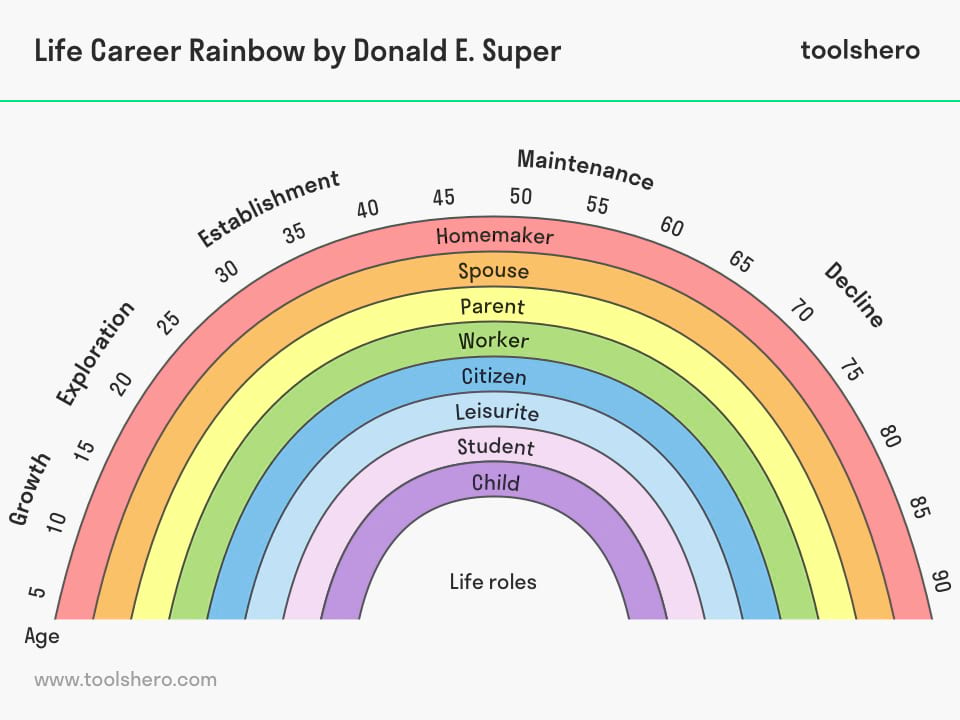Super’s Life Career Rainbow

Super’s Life Career Rainbow: this article explains Donald Super’s Life Career Rainbow in a practical way. After reading it, you will understand the basics of this powerful Personal Happiness and motivation theory.
What is Donald Super’s Life Career Rainbow?
The American psychologist Donald E. Super developed innovative ideas on life planning within career development.
In 1980, he introduced the Life Career Rainbow; the theory that describes career development in terms of life stages and life roles. The 1957 book ‘the psychology of careers’ was the basis for this. The development of careers was a new phenomenon in the 1950s.
Until then people just worked at an organisation, and it was unusual for people to be concerned with career plans and future personal development. Based on the vision of human relations theory, which came to the fore in the early sixties, it did fit to have more attention for individual employees.
Work-life balance
According to Donald Super, it’s vital that there is a good balance between work and private life; the so-called ‘work-life balance’. Every person plays different roles and also goes through various stages of life. This also affects their career.
These changes affect the demands that people place themselves and their work. When the different roles in one’s life collide, it can lead to stressful situations. That’s why there is value in people being able to examine their own core interests and attach a certain importance to this.
According to Donald Super, a life structure is not static, but rather dynamic and always in development. With his Life Career Rainbow, he embraces this fact and makes people think about the different roles they play at different moments in life.
Rainbow
The Life Career Rainbow is a visual model that reflects a rainbow. The life roles are shown in the coloured stripes of the rainbow. The age is written with numbers under these stripes. The size of the dots in the coloured stripes indicate the time that takes a life role up:
Outer edge of the rainbow
This indicates the life cycle of career development. It starts at the bottom left and runs chronologically to the right up to a maximum of 5 years in the future.
Above and in the middle of the rainbow
This describes the situation in which someone is in, such as socioeconomic status, background, history and other activities that can influence the role of life.
Under and in the middle of the rainbow
Here are the factors that influence personal development, such as psychological and biological factors.
Life Career Rainbow : Lifespan
Donald Super indicated that the life of a person has a certain lifespan, characterised by different life stages. Each stage is decisive for the career that one has at that moment. Super identified five stages, each with its own characteristic:
1. Growth (youth) 0 to 14 years
This is the first early stage of human life, in which physical growth is the central focus. Interests, talents and capacity will develop.
2. Exploration (adolescence) 14-25 years
This is the phase of exploration and growth towards adulthood, in which puberty plays an important part. People come into contact with work for the first time and learn what’s important to be successful in different careers. At the end of this phase, people know what their career prospects are.
3. Establishment (young adulthood) 26-45 years
This is the phase in which one is settled, a family is founded, a study programme has been completed, and a permanent job has been found. Taking responsibility and personal satisfaction from work are characteristic of this phase.
4. Maintenance (middle-aged) 46-65 years
During this phase, people choose job security. Change of career may take place once more at the beginning of this phase.
5. Withdrawal (late adulthood) from age 65
This is the phase of acceptance, in which one looks back on their working life. The emphasis shifts from paid work to relaxation and acquiescence.
Life roles
In describing the life structure, Super identifies eight primary roles that people take during their lifetime. In addition to the life stages, these also form part of the Life Career Rainbow:
1. Child
Every person is someone’s child. This role starts at birth and continues until both parents have died. At first, the child needs help, but as the child gets older, they will ultimately take care of the parents.
2. Student
People spend a lot of time at school; usually from 4 to 18 years. After that, you can take a follow-up course or take seminars, training courses or further training programmes during your work. The student is eager to learn and curious.
3. Leisurite
This word Super conceived for humans who are able to recreate and relax. This holidaymaker has a hedonistic lifestyle and the role is mainly occupied by young people and pensioners.
4. Citizen
This is the social role that people take by, for example, volunteering or caring for neighbours, family or friends.
5. Employee
This is the role of the paid employee, who is responsible for the work for which they were hired.
6. Parent
This describes the parent role, which educates children and is responsible for them. In the first instance it is a major care task, but as the children grow up it decreases.
7. Partner
This is the role of dedication to the partner with whom life is shared. Even people who remain single can take this role when it comes to friendship.
8. Housewife
This is not necessarily a female role; everyone who goes to live on their own fulfils this role and is responsible for his or her household.
Application Super’s Life Career Rainbow
A good work-life balance can be found with the Life Career Rainbow. It provides insight into the balance between work and private life, and how this can be improved. A direct application can be based on 5 steps:
Step 1
An evaluation of the current balance between work and private life. Based on the 8 life roles, you can mark in a circle how much (per cent) one spends on each of them.
Step 2
Description of the ideal balance between work and private life; what one finds important and how much time one thinks to spend on this. Here too, the required amount of time per role is marked in a circle.
Step 3
A reflection on what one would want in five years in the field of work-life balance. What is the desired lifestyle?
Step 4
This is the most confrontational step, in which one looks at differences between the circle from step 1 and the desired circles from step 2 and 3. The differences are identified and people look for the causes.
Step 5
In this step the confrontation starts. Goals are developed to develop the ideal work-life balance. A substantial change in work-life balance must be well thought-out and carefully prepared. Only then is there really a chance of success regarding a better work-life balance.
It’s Your Turn
What do you think? Have you ever heard of Donald Super’s Life Career Rainbow? Do you recognize the practical explanation or do you have more suggestions? What are your success factors for personal happiness and how do you get motivated?
Share your experience and knowledge in the comments box below.
More information
- Blustein, D. L. (1997). A context‐rich perspective of career exploration across the life roles. The Career Development Quarterly, 45(3), 260-274.
- Super, D. E. (1980). A life-span, life-space approach to career development. Journal of vocational behavior, 16(3), 282-298.
- Super, D. E. (1957). The psychology of careers; an introduction to vocational development.
How to cite this article:
Mulder, P. (2018). Super’s Life Career Rainbow. Retrieved [insert date] from Toolshero: https://www.toolshero.com/psychology/life-career-rainbow/
Published on: 19/10/2018 | Last update: 04/05/2022
Add a link to this page on your website:
<a href=”https://www.toolshero.com/psychology/life-career-rainbow/”>Toolshero: Super’s Life Career Rainbow</a>













